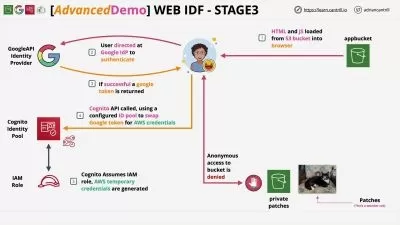AWS CloudFormation In-Depth
Uday Kiran
12:43:36
Description
Explained CloudFormation in detail
What You'll Learn?
- CloudFormation and Infrastructure Deployment
- AWS and resources created using the IAC
- Infrastructure as a code using CF
- CloudFormation deployment using CodePipeline and CodeDeploy
Who is this for?
More details
DescriptionAWS CloudFormation is a service that helps you model and set up your AWS resources so that you can spend less time managing those resources and more time focusing on your applications that run in AWS. You create a template that describes all the AWS resources that you want (like Amazon EC2 instances or Amazon RDS DB instances), and CloudFormation takes care of provisioning and configuring those resources for you. You don't need to individually create and configure AWS resources and figure out what's dependent on what; CloudFormation handles that. The following scenarios demonstrate how CloudFormation can help.
For a scalable web application that also includes a backend database, you might use an Auto Scaling group, an Elastic Load Balancing load balancer, and an Amazon Relational Database Service database instance. You might use each individual service to provision these resources and after you create the resources, you would have to configure them to work together. All these tasks can add complexity and time before you even get your application up and running.
Instead, you can create a CloudFormation template or modify an existing one. A template describes all your resources and their properties. When you use that template to create a CloudFormation stack, CloudFormation provisions the Auto Scaling group, load balancer, and database for you. After the stack has been successfully created, your AWS resources are up and running. You can delete the stack just as easily, which deletes all the resources in the stack. By using CloudFormation, you easily manage a collection of resources as a single unit.
This course is a recording for Corporate training provided on AWSÂ in detail for 16 hours and included all the resources and solutions provided to them.
Who this course is for:
- Beginner Infrastructure engineers
AWS CloudFormation is a service that helps you model and set up your AWS resources so that you can spend less time managing those resources and more time focusing on your applications that run in AWS. You create a template that describes all the AWS resources that you want (like Amazon EC2 instances or Amazon RDS DB instances), and CloudFormation takes care of provisioning and configuring those resources for you. You don't need to individually create and configure AWS resources and figure out what's dependent on what; CloudFormation handles that. The following scenarios demonstrate how CloudFormation can help.
For a scalable web application that also includes a backend database, you might use an Auto Scaling group, an Elastic Load Balancing load balancer, and an Amazon Relational Database Service database instance. You might use each individual service to provision these resources and after you create the resources, you would have to configure them to work together. All these tasks can add complexity and time before you even get your application up and running.
Instead, you can create a CloudFormation template or modify an existing one. A template describes all your resources and their properties. When you use that template to create a CloudFormation stack, CloudFormation provisions the Auto Scaling group, load balancer, and database for you. After the stack has been successfully created, your AWS resources are up and running. You can delete the stack just as easily, which deletes all the resources in the stack. By using CloudFormation, you easily manage a collection of resources as a single unit.
This course is a recording for Corporate training provided on AWSÂ in detail for 16 hours and included all the resources and solutions provided to them.
Who this course is for:
- Beginner Infrastructure engineers
User Reviews
Rating
Uday Kiran
Instructor's Courses
Udemy
View courses Udemy- language english
- Training sessions 9
- duration 12:43:36
- Release Date 2023/03/29















